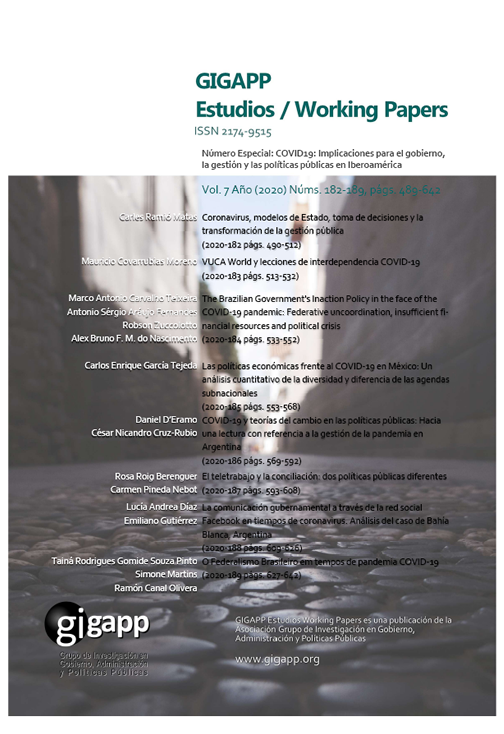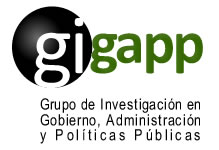La comunicación gubernamental a través de la red social Facebook en tiempos de coronavirus. Análisis del caso de Bahía Blanca, Argentina
Resumen
La ciudad de Bahía Blanca, Argentina, ha sido pionera en la región, desde ya varias décadas, en el desarrollo de gobierno electrónico y en el uso de las redes sociales para la difusión y comunicación de información dirigida a los ciudadanos. Frente al contexto global de pandemia a causa del COVID-19 y utilizando las herramientas digitales disponibles, el Municipio de esta localidad potenció el uso de gobierno electrónico para comunicar diariamente las novedades y acciones llevadas a cabo en tal situación. En este trabajo, en particular, se analiza la actividad del gobierno local en su página de la red social Facebook a fin de detectar los factores que influyen en una mayor interacción en los posteos en esta plataforma digital. Como resultados relevantes se destaca una relación positiva entre la popularidad de una publicación y menciones asociadas al COVID-19, a la cuarentena y a iniciativas solidarias por parte de los ciudadanos.
Descargas
Citas
Al- Jamal y Abu-Shanab. 2011. “E-Government Adoption in Jordan: The Influence of Age”. 7th Interna-tional Conference on Information Technology, 345-350.
Alderete, V. y Díaz, L. 2019. ¿Participa la ciudadanía en el gobierno electrónico? Resultados preliminares en la ciudad de Bahía Blanca. 4° Congreso Latinoamericano de Estudios Urbanos. “Transformacio-nes Metropolitanas en América Latina. La investigación frente a nuevos desafíos”. Universidad Ge-neral Sarmiento, Buenos Aires, Argentina (Octubre 2019).
Amadeo, Belén. 2007. Comunicación gubernamental e internet en la república argentina. Comunicación efectuada en la Academia Nacional de Ciencias de Buenos Aires en la sesión privada extraordinaria del 18 de octubre de 2007
Antoniadis, I., Simos, P. Y Assimakopoulos, C. 2018. Factors affecting engagement and reactions of posts in Greek Facebook brand pages. 6th International Conference on Contemporary Marketing Issues.
Bonina, C. M. y Lepore, W. 2005. Desafíos y oportunidades del gobierno electrónico en el marco de la nueva gestión pública: el caso de Argentina. X Congreso Internacional del CLAD sobre la Reforma del Estado y de la Administración Pública, Santiago, Chile, 18-21 Oct. 2005
Buddy Media INC. 2011. Strategies for effective facebook wall posts: a statistical review.
Cameron, A. C. Y Trivedi, P. 2009. Regression Analysis of Count Data. Cambridge University Press.
Castillo-Esparcia, Antonio; Fernández-Souto, Ana-Belén; Puentes-Rivera, Iván. 2020. “Comunicación política y Covid-19. Estrategias del Gobierno de España”. Profesional de la información, v. 29, n. 4,
Ciucci, F., Díaz, L., Alderete, M.V. y Linares, S. 2019. “Construcción de un índice para medir la transparen-cia municipal: Buenos Aires, Bahía Blanca y las capitales de provincia de Argentina”, Revista RIEM Revista Iberoamericana de Estudios Municipales, 20 (10), 59-84.
García Aguilar, José A., 2012. “La crisis de las Redes Sociales de Gobierno”. PAAKAT: Revista de Tecno-logía y Sociedad. 3 (2)
Graham M., y Avery, E. 2013. Government Public Relations and Social Media: An Analysis of the Percep-tions and Trends of Social Media Use at the Local Government Level. Public Relations Journal, 7, 1-21.
Khasawneh E. y Abu-Shanab A. 2013. E-Goverment and Social Media Sites: The Role and Impact. World Journal of Computer Aplicattion and Technology 1 (1). 10-17.
Kwok, L., y Yu, B. 2013. Spreading Social Media Messages on Facebook: An Analysis of Restaurant Busi-ness-to-Consumer Communications. Cornell Hospitality Quarterly, 54(1), 84-94.
Llano Guibarra, Ninón I. y Aguila Sánchez, Julio C. 2020. “Conferencias de prensa y COVD-19: explorando la respuesta gubernamental mexicana desde la comunicación en salud”. Revista española de comu-nicación en salud, 2020, suplemento 1: 128-141
Martínez, R., Rodríguez R., Vera P. y Parkinson, C. 2019. Análisis de técnicas de raspado de datos en la web – aplicado al portal del estado nacional argentino. XXV Congreso Argentino de Ciencias de la Computación.
Mohammadi, S., Farahbakhsh, R. y Crespi, N. 2017. Popularity evolution of professional users on face-book2017 IEEE International Conference on Communications (ICC), 1-6.
Municipalidad de Bahía Blanca. 2020. https://gobiernoabierto.bahia.gob.ar/
Nacke, M., Calamari, M., Fernández Arroyo, N., y Pando, D. 2013. Índice nacional de páginas webs munici-pales. Balances a 5 años de su implementación. En D. Pando y N. Fernández Arroyo (Eds.), en El go-bierno electrónico a nivel local. experiencias, tendencias y reflexiones. (1a ed., pp. 7–28). Buenos Aires: CIPPEC y Universidad de San Andrés.
Naser, A. y Concha, G. 2011. El gobierno electrónico en la gestión pública. Instituto Latinoamericano y del Caribe de Planificación Económica y Social (ILPES), CEPAL. Chile
Open Government Partnership. 2020. https://www.opengovpartnership.org
Pando, Diego. 2012. en Informe anual “Índice Nacional de Páginas Web Municipales 2012”, Programa de Desarrollo Local de CIPPEC (Centro de Implementación de Políticas Públicas para la Equidad y el Crecimiento) y el Programa de Gobierno Electrónico de la Universidad de San Andrés.
Peters, M. A., Jandrić, P., & McLaren, P. 2020. “Viral modernity? epidemics, infodemics, and the ‘bioin-formational’ paradigm”. Educational Philosophy and Theory, 1-23
Poggi, E. 2013. Gobierno electrónico, gobierno local y gestión tecnológica, en Pando, D. y Fernández Arroyo, N. (comp.). El gobierno electrónico a nivel local. Experiencias, tendencias y reflexiones. Buenos Aires: CIPPEC y Universidad de San Andrés.
Rauschnabel, P., Praxmarer, S. y Ivens B. 2012. Social Media Marketing: How Design Features Influence Interactions with Brand Postings on Facebook. En Eisend M., Langner T., Okazaki S. (eds) Advances in Advertising Research (Vol. III). European Advertising Academy. Gabler Verlag, Wiesbaden.
Sabate, F., Berbegal-Mirabent, J., Cañabate C., y Lebherz, P. 2014. Factors influencing popularity of branded content in Facebook fan pages. European Management Journal 32(6), 1001-1011.
Schmidt R., Möhring M., Härting R.C., Reichstein C., Keller B. 2016. Influencing Factors Increasing Popu-larity on Facebook – Empirical Insights from European Users. En: Abramowicz W., Alt R., Franczyk B. (eds) Business Information Systems. BIS 2016. Lecture Notes in Business Information Processing, vol 255. Springer, Cham.
Sistema de Información Cultural de la Argentina (SINCA). 2017. Encuesta Nacional de Consumos Cultura-les. Ministerio de Cultura. Argentina.
Tarullo, María Raquel. 2015. “Las redes sociales en la comunicación de gobierno: una aproximación teóri-ca”. Revista de Investigación del Departamento de Humanidades y Ciencias Sociales. Universidad Nacional de La Matanza. 4, N°7: 89-104
Valenti, Paulo (2013) Manual de Orientación para participar en Redes Sociales. Banco Interamericano de Desarrollo y Secretaría de Comunicación de Brasil. Disponible en http://www.iadb.org/es/publicaciones/detalle,7101.html?id=68908
Valerio G., Herrera N., Herrera D., y Rodríguez MC. 2014. "En Facebook el tamaño sí importa. Engagement y el impacto de la longitud del mensaje en las fanpages de las universidades mexicanas." Revista Digital Universitaria 15 (2).
Vargas Díaz, César D. 2011. “El Gobierno Electrónico o e-Gobierno” Uni-pluri/versidad Vol.11 N.1. Univer-sidad de Antioquía. Medellín. Colombia
Wilson, M. E., & Chen, L. H. 2020) “Travelers Give Wings to Novel Coronavirus” (2019- nCoV). Journal of Travel Medicine, 27(2), 1-3.
Wong, C. M. L., & Jensen, O. 2020 “The paradox of trust: perceived risk and public compliance during the COVID-19 pandemic in Singapore”. Journal of Risk Research, 1-10.
Derechos de autor 2020 Lucia Andrea Diaz, Emiliano Gutiérrez (Autor/a)

Esta obra está bajo licencia internacional Creative Commons Reconocimiento-NoComercial-CompartirIgual 4.0.
Aquellos autores/as que tengan publicaciones con esta revista, aceptan los términos siguientes:
a. Los autores/as conservarán sus derechos de autor y garantizarán a la revista el derecho de primera publicación de su obra, el cuál estará simultáneamente sujeto a la Licencia de reconocimiento de Creative Commons Attribution-NonCommercial-ShareAlike 4.0 International (CC BY-NC-SA 4.0) que permite a terceros compartir la obra siempre que se indique su autor y su primera publicación esta revista.
Con esta licencia de acceso abierto, los lectores (usuarios) pueden:
- Compartir — copiar y redistribuir el material en cualquier medio o formato
- Adaptar — remezclar, transformar y construir a partir del material
Bajo los siguientes términos:
-
Atribución — usarios deberán dar crédito de manera adecuada, brindar un enlace a la licencia, e indicar si se han realizado cambios. Puede hacerlo en cualquier forma razonable, pero no de forma tal que sugiera que usted o su uso tienen el apoyo de la licenciante.
-
NoComercial — usuarios no puede hacer uso del material con propósitos comerciales.
-
CompartirIgual — Si remezcla, transforma o crea a partir del material, usuarios deben distribuir su contribución bajo la misma licencia del original.
-
Sin restricciones adicionales: los usuarios no pueden aplicar términos legales o medidas tecnológicas que restrinjan legalmente a otros de hacer cualquier cosa que permita la licencia.
b. Los autores/as podrán adoptar otros acuerdos de licencia no exclusiva de distribución de la versión de la obra publicada (p. ej.: depositarla en un archivo telemático institucional o publicarla en un volumen monográfico) siempre que se indique la publicación inicial en esta revista
c. Se permite y recomienda a los autores/as difundir su obra a través de Internet (p. ej.: en archivos telemáticos institucionales o en su página web) antes y durante el proceso de envío, lo cual puede producir intercambios interesantes y aumentar las citas de la obra publicada. (Véase El efecto del acceso abierto).



